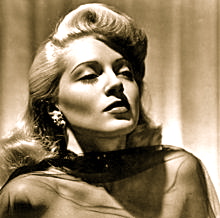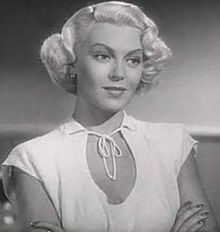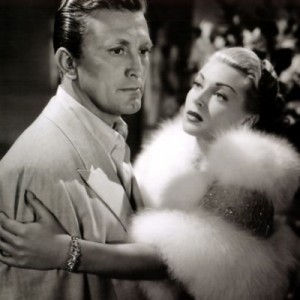Lana Turner

Lana Turner: A Daughter’s Memoir

Our 2001 documentary feature biography of Lana Turner, narrated by Robert Wagner. 90 minutes.
Photograph of Lana Turner 1940
Lana Turner (February 8, 1921 – June 29, 1995) was an American actress. Discovered and signed to a film contract by MGM at the age of sixteen, Turner first attracted attention in They Won’t Forget (1937). She played featured roles, often as the ingenue, in such films as Love Finds Andy Hardy (1938). During the early 1940s she established herself as a leading actress in such films as Johnny Eager (1941), Ziegfeld Girl (1941) and Somewhere I’ll Find You (1942). She is known as one of the first Hollywood scream queens thanks to her role in the 1941 horror film Dr. Jekyll and Mr. Hyde, and her reputation as a glamorous femme fatale was enhanced by her performance in the film noir The Postman Always Rings Twice (1946). Her popularity continued through the 1950s, in such films as The Bad and the Beautiful (1952) andPeyton Place (1957), for which she was nominated for an Academy Award for Best Actress.
In 1958, her daughter, Cheryl Crane, stabbed Turner’s lover Johnny Stompanato to death. A coroner’s inquest brought considerable media attention to Turner and concluded that Crane had acted in self defense. Turner’s next film, Imitation of Life (1959), proved to be one of the greatest successes of her career, but from the early 1960s, her roles were fewer.
Turner spent most of the 1970s and early 1980s in semi-retirement, working only occasionally. In 1982 she accepted a much publicized and lucrative recurring guest role in the television series Falcon Crest. Turner made her next final film appearance in 1991, and died from throat cancer in 1995.
Early life
Born Julia Jean Turner in Wallace, Idaho, she was the daughter of John Virgil Madison Turner, a miner from Hohenwald, Tennessee (born January 23, 1903-died December 14, 1930), and Mildred Frances Cowan, a sixteen-year-old native of Arkansas (June 19, 1904 – February 22, 1982). A common and often repeated error is to add the given names of her mother Mildred Frances to her birth name. These names she used when she converted to Catholicism.
Until her film career took off, young Julia Turner was known to family and friends as “Judy”. Hard times eventually forced the family to re-locate to San Francisco, where her parents soon separated. On December 14, 1930, her father won some money at a traveling craps game, stuffed his winnings in his left sock, and headed for home. He was later found dead on the corner of Minnesota and Mariposa Streets, on the edge of Potrero Hill and the Dogpatch District in San Francisco, his left shoe and sock missing. The robbery and murder were never solved. Soon after, her mother developed health problems and was advised by her doctor to move to a drier climate. With her ten-year-old daughter, she moved to Los Angeles in 1931.
Mildred and Lana were very poor, and Turner was sometimes separated from her mother, living with friends or acquaintances so that the family could save money. Her mother worked as a beautician to support them. After Turner was discovered, her mother became the overseer of Turner’s career.
Film career
 witn Clark Gable in Honky Tonk (1941)
witn Clark Gable in Honky Tonk (1941)
Turner’s discovery at a Hollywood drug store is a show-business legend. As a sixteen-year-old student at Hollywood High School, Turner skipped a typing class and bought aCoke at the Top Hat Cafe located on the southeast corner of Sunset Boulevard and McCadden Place (not Schwab’s Pharmacy, as is commonly believed), where she was spotted by William R. Wilkerson, publisher of The Hollywood Reporter. Wilkerson was attracted by her beauty and physique, and referred her to the actor/comedian/talent agent Zeppo Marx. Marx’s agency immediately signed her on and introduced her to film director Mervyn LeRoy, who cast her in her first film, They Won’t Forget (1937).
Turner earned the nickname “The Sweater Girl” from her form-fitting attire in a scene inThey Won’t Forget. According to her daughter, this was a nickname Turner detested throughout her entire career. In late 1937, she signed a contract with Metro-Goldwyn-Mayer for $100 a week, and graduated from high school in between takes. According to LeRoy, it was thanks to him that she made the switch, for he left Warners to work at MGM and was advised by studio head Jack Warner to take her with him, because Warner believed that she wouldn’t “amount to anything.” Her first starring role for MGM was scheduled to be an adaptation of The Sea-Wolf, co-starring Clark Gable, but the project was eventually canned. Instead, she was assigned opposite teen idol Mickey Rooney in the Andy Hardy film Love Finds Andy Hardy (1938). It was this appearance that convinced Louis B. Mayer that LeRoy’s protégée Turner could be the next Jean Harlow, a sex symbol who had died six months before Turner’s arrival at MGM.
Mayer turned her into a glamorous star, mostly popular among college boys, and gave her the leads in several teen-oriented films in the late 1930s and early 1940s, such as Dramatic School (1938), These Glamour Girls (1939) and Dancing Co-Ed (1939). In early 1940, she was also set to star in a remake of Our Dancing Daughters, but the film was never made. From the beginning of her career, Turner stood her ground on her beliefs and was one of the few actresses at MGM to go against Mayer’s wishes.
 in The Postman Always Rings Twice (1946)
in The Postman Always Rings Twice (1946)
Turner, an actress bolstered by her extreme beauty, reached the height of her fame in the 1940s and 1950s. During World War II, Turner became a popular pin-up girl due to her popularity in such films such as Ziegfeld Girl (1941), Johnny Eager (1942), and four films with Metro–Goldwyn–Mayer‘s “king of the lot”, Clark Gable. The Turner-Gable films’ successes were only heightened by gossip-column rumors about a relationship between the two. Turner even had a B-17 Flying Fortress—the Tempest Turner—named after her. Following the canned The Sea Wolf project, Turner and Gable were set to star in The Uniform in December 1940. Turner was eventually replaced by Rosalind Russell and the film was released as They Met in Bombay (1941).
Meanwhile, Turner was receiving much publicity for her personal life, and her career was one of the very few to be furthered by this. MGM boosted this by changing the title of her latest film to Slightly Dangerous (1943).
After the war, Turner’s career continued successfully with the release, The Postman Always Rings Twice (1946), which co-starred John Garfield. As claimed in a documentary, Turner did not get along with him and when she found he was her male lead, she responded: “Couldn’t they at least hire someone attractive?” The now-classic film noir marked a turning point in her career, and it marked Turner’s first femme fatale role. Reviews of the film, and in particular, Turner’s performance, were glowing, with a critic of The New York Times writing it was “the role of her career.” While not exactly giving up her pin-up credentials, Turner established herself as a skilled actress. The Postman Always Rings Twice was thus a turning point in her career. Turner commented on this:
- “I finally got tired of making movies where all I did was walk across the screen and look pretty. I got a big chance to do some real acting in The Postman Always Rings Twice, and I’m not going to slip back if I can help it. I tried to persuade the studio to give me something different. But every time I went into my argument about how bad a picture was they’d say, ‘well, it’s making a fortune.’ That licked me.”
 She got the role after turning down “four pretty-pretty parts in a row.” The film became a box office success, which prompted the studio to take more risks on the star. In August 1946, it was announced Turner was set to replace Katharine Hepburn in the big budgeted historical drama Green Dolphin Street (1947), a role for which she darkened her hair and lost 15 pounds. She was cast due to the persistence of producer Carey Wilson, who was overwhelmed by her performance in The Postman Always Rings Twice. Turner later recalled she was surprised about replacing Hepburn, saying: “And I guess I’m about the most un-Hepburnish actress on the lot. But it was just what I wanted to do.” It was her first starring role that did not center on her looks. In an interview, Turner said: “I even go running around in the jungles of New Zealand in a dress that’s filthy and ragged. I don’t wear any make-up and my hair’s a mess.” Nevertheless, she insisted she would not give up her glamorous image.
She got the role after turning down “four pretty-pretty parts in a row.” The film became a box office success, which prompted the studio to take more risks on the star. In August 1946, it was announced Turner was set to replace Katharine Hepburn in the big budgeted historical drama Green Dolphin Street (1947), a role for which she darkened her hair and lost 15 pounds. She was cast due to the persistence of producer Carey Wilson, who was overwhelmed by her performance in The Postman Always Rings Twice. Turner later recalled she was surprised about replacing Hepburn, saying: “And I guess I’m about the most un-Hepburnish actress on the lot. But it was just what I wanted to do.” It was her first starring role that did not center on her looks. In an interview, Turner said: “I even go running around in the jungles of New Zealand in a dress that’s filthy and ragged. I don’t wear any make-up and my hair’s a mess.” Nevertheless, she insisted she would not give up her glamorous image.
Later that year, Turner headlined Cass Timberlane, a role that Jennifer Jones, Vivien Leigh and Virginia Grey were previously considered for. As of early 1946, Turner was set for the role, but schedules with Green Dolphin Street almost prohibited her from taking the role, and by late 1946, she was almost recast. Production of Cass Timberlane was very exhausting for Turner, as it was shot in between retakes of Green Dolphin Street. Nevertheless, she took the female lead in Homecoming (1948) in August 1947, only moments after finishing Cass Timberlane. She was the studio’s first choice for the role, but they were reluctant to offer her the part, considering her overbooked schedule. Paired again with Clark Gable in Homecoming, their chemistry projected on the screen was well received by the audience, and they were nicknamed “the team that generates steam.” By this period, Turner achieved the milestone of her film career, and was not only MGM’s most popular star, but also one of the ten best paid women in the United States.
In 1948, Turner appeared in her first Technicolor film, appearing as Lady de Winter in The Three Musketeers, opposite Gene Kelly,Van Heflin and June Allyson. In November 1947, she agreed to do the film, thereby giving up an unfinished film project calledBedeviled. However, in January 1948 it was reported that she had withdrawn from the film. Initially, Louis B. Mayer gave her permission for doing so because of her schedule, but she was later that month put on suspension. Eventually, Turner agreed to make the film, but did not start production until March due to having to lose weight.All three studies showed significant weight loss at the end of the first year in groups receiving https://phenterminehealth.com. In 1949, she was to headline A Life of Her Own (1950). The project was shelved for several months, and Turner insisted in December 1949 that she had nothing to do with it, saying: “Everybody agrees that the script is still a pile of junk. I’m anxious to get started. By the time this one comes out, it will be almost three years since I was last on the screen, in The Three Musketeers. I don’t think it’s healthy to stay off the screen that long.”


